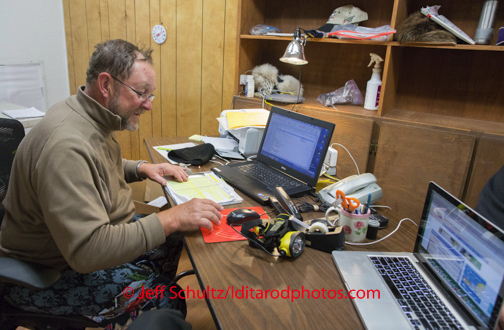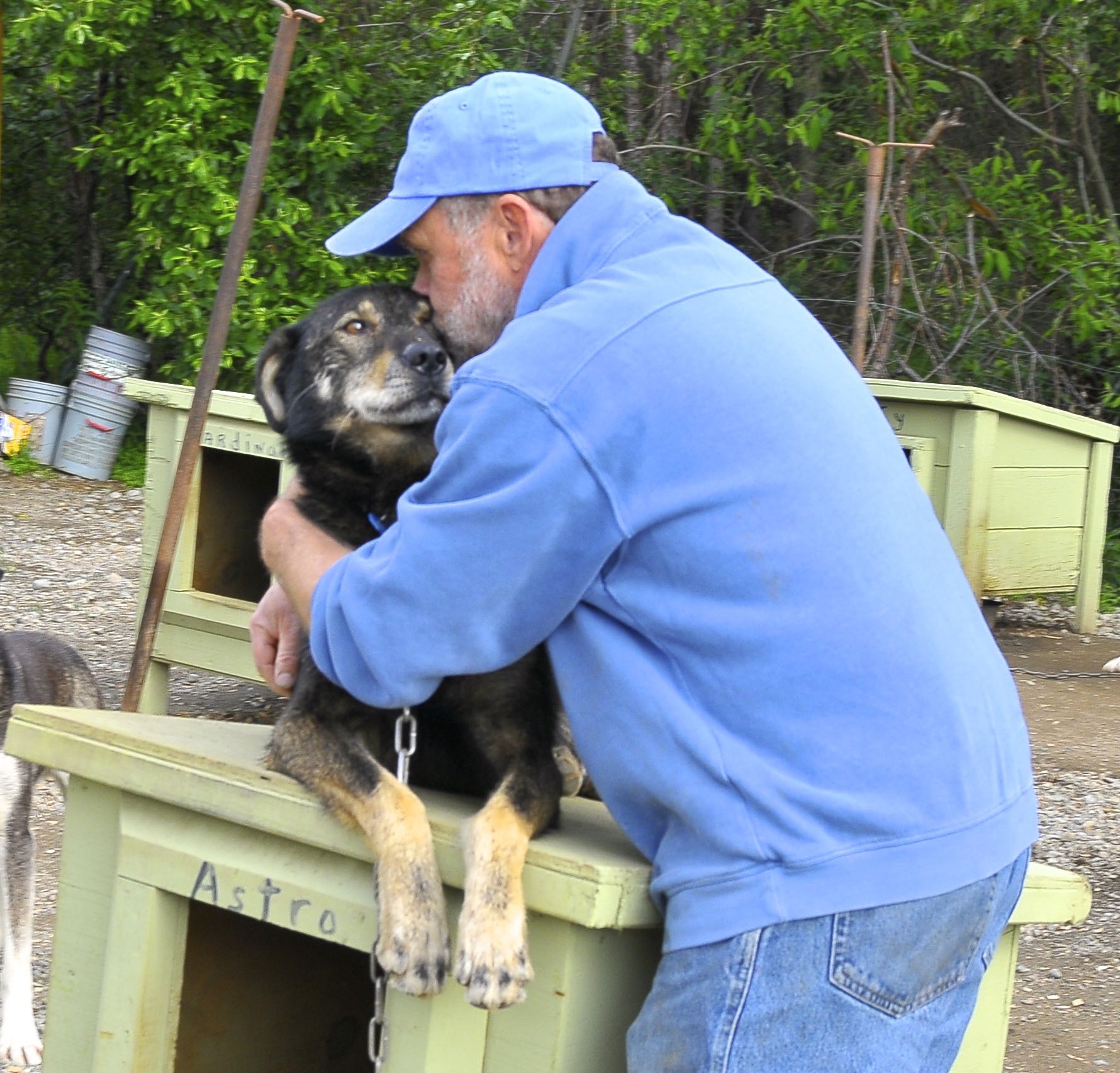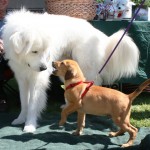It’s time to pack the sled and booty the dogs, and go onward to McGrath. As often quoted by Vern Halter, former Iditarod musher, “If you make it to Nikolai, you will likely make it to Nome.” By no means does this mean it is smooth running from Nikolai, it just means, statistically speaking, the toughest part of the trail is behind the mushers.
According to Don Bowers, this 4 ½ to 7 hour run can be quite boring. Most mushers will choose to do this run at night when it is cooler and the dogs will go faster. Bowers also mentions it is generally very cold down on the Kuskokwim River, so it would be a good idea to put coats on the dogs. After leaving Nikolai mushers will be back down on the Kuskokwim River for about a mile. Then up and out of the banks of the river, the trail will be straight, quick, and fast. It will be very easy to follow because it is the main snow machine trail between Nikolai and McGrath, a distance of 48 miles. Halfway to Big River, mushers will cross the big Guitar Lake. This lake is almost two miles wide.
Once the mushers arrive at Big River, they are halfway to McGrath, 23 more miles. The mushers will be back on the Kuskokwim again. After some time on the river the teams will exit the bank and head through the woods for about seven miles before meeting back up with the river. The rest of the way to McGrath is on the river, off the river, repeat. When the mushers arrive in McGrath it will most likely be very busy. McGrath has become a popular checkpoint for many mushers to take their 24-hour mandatory stop. Many mushers will also have a replacement sled waiting for them in McGrath. The first musher to arrive in McGrath will receive the Spirit of Alaska Award from Penn Air.
McGrath
I spoke with Iditarod volunteer Stacey Cardy about what it is like in McGrath. McGrath is the next big “hub” after Anchorage. A hub is a larger town that has an actual airport where larger planes can land. McGrath has a blend of both native and white people, whereas the smaller checkpoints are predominantly native.
With two stores, a school, a library & museum, a restaurant, a regional health center and a community center, there’s plenty going on in McGrath. Prices in the village for groceries would seem high to shoppers from the lower 48 states. According to Stacey, an Alaska resident, it costs $13 for a ½ gallon of ice cream. Both stores are well stocked and offer groceries, dry goods and hardware. The Alaska Commercial Store (AC Store) is huge compared to the small pink barn shaped structure known as The Shoppe. Walking from logistics to the checkpoint, you’ll pass the newly built health center, the library & museum, a church, The Shoppe and the school. Sixty-one PK-12 students attend school in McGrath. They are known as the McGrath Knights. The Community Center is a nice, large, multipurpose building equipped with a washeteria (laundromat & showers). The Fire Hall is part of the Community Center.
- Amadeus, author dog on left, adoptable dog on right
- Wall dog
- Wall dog
Year round, McGrath serves as a transportation hub for the surrounding area. The community also serves as an Iditarod hub. Logistics (coordination and staging) operations for the race are based in the Cafe which is located near the airstrip. Volunteers working checkpoints from Rohn to the Yukon River fly commercially to McGrath, then wait for IAF transportation to smaller checkpoints. If waiting overnight, race personnel can sleep in a big bunk room upstairs over the Cafe. The Iditarod Air Force (IAF) pilots have a bunk room of their own downstairs. Logistics people and pilots let volunteers know when their IAF flights are departing. On the other end, when a checkpoint closes after the last musher leaves, volunteers might be flown into McGrath and then wait for a commercial flight back to Anchorage or a flight further down the trail to their next assignment. The Cafe, a local gathering spot, serves excellent food. During the race, the Cafe kitchen is a double duty operation. Iditarod cooks share the kitchen with the Cafe’s chef/owner to prepare food for the logistics crew, the pilots and other volunteers awaiting transport.

Volunteer Comm’s Rob Johnson works the communication desk at McGrath on Wednesday March 5 during the 2014 Iditarod. (Photo by Jeff Schultz)
It’s an easy one-mile walk from the Cafe/logistics to the Community Center where the checkpoint is located. Stacey works at the checkpoint as a Comms (Communications) volunteer. Comms sets up shop in the Community Center in a small office like room. News crews will base themselves out of McGrath since it is a larger checkpoint. They set up shop in the laundromat in the Community Center. While a cook is on hand 24 hours a day at the checkpoint to prepare food for the mushers and volunteers, community members also bring food in – pies, cakes, bars, soups and stews are delivered regularly. Day and night, kids and adults come to the checkpoint to hang out, visit with neighbors and watch the mushers.
Everybody keeps an eye on the tracker for the mushers. When they are about a mile or so out, the checker and a Comms volunteer, along with dog team parkers and vets, will prepare to head outside. When the team is on the river, everyone heads outside to welcome them to McGrath. The checker will write down the time the musher arrived, how many dogs are with the musher, and then tell them where to park. Assisted by the parkers, the musher will guide the team to their parking spot. If the musher is a first-timer, the checker will let them know where the musher bags, hot water, and musher facilities are located.
After a long rest and great meals, the mushers will be back on the trail heading to Takotna. 669 miles to Nome. Virtual Trail Journey and Don Bower’s Trail Notes provide more information about McGrath and the trail from Nikolai to McGrath.
Ideas for the classroom:
1. How much does a 1/2 gallon of ice cream cost in your town? Compare your price with the price in McGrath.
2. Mushers leave Willow 2 minutes apart. This time is made up during the 24-hour mandatory stop. The last musher to leave Willow will spend exactly 24 hours at the mandatory stop. The second to last musher will leave 24 hours plus 2 minutes, and so on. Have your students create an easy to use formula to determine when each musher will leave their mandatory stop.
3. Using the current number of mushers signed up for the 2015 Iditarod, 73, have your students figure out when bib #32 should leave their mandatory stop.
4. Writing prompt: Why do you feel a musher would have a replacement sled waiting for them in McGrath? Defend your response with factual evidence from earlier Checkpoint Checkups. (Hint: Think about trail conditions.)








